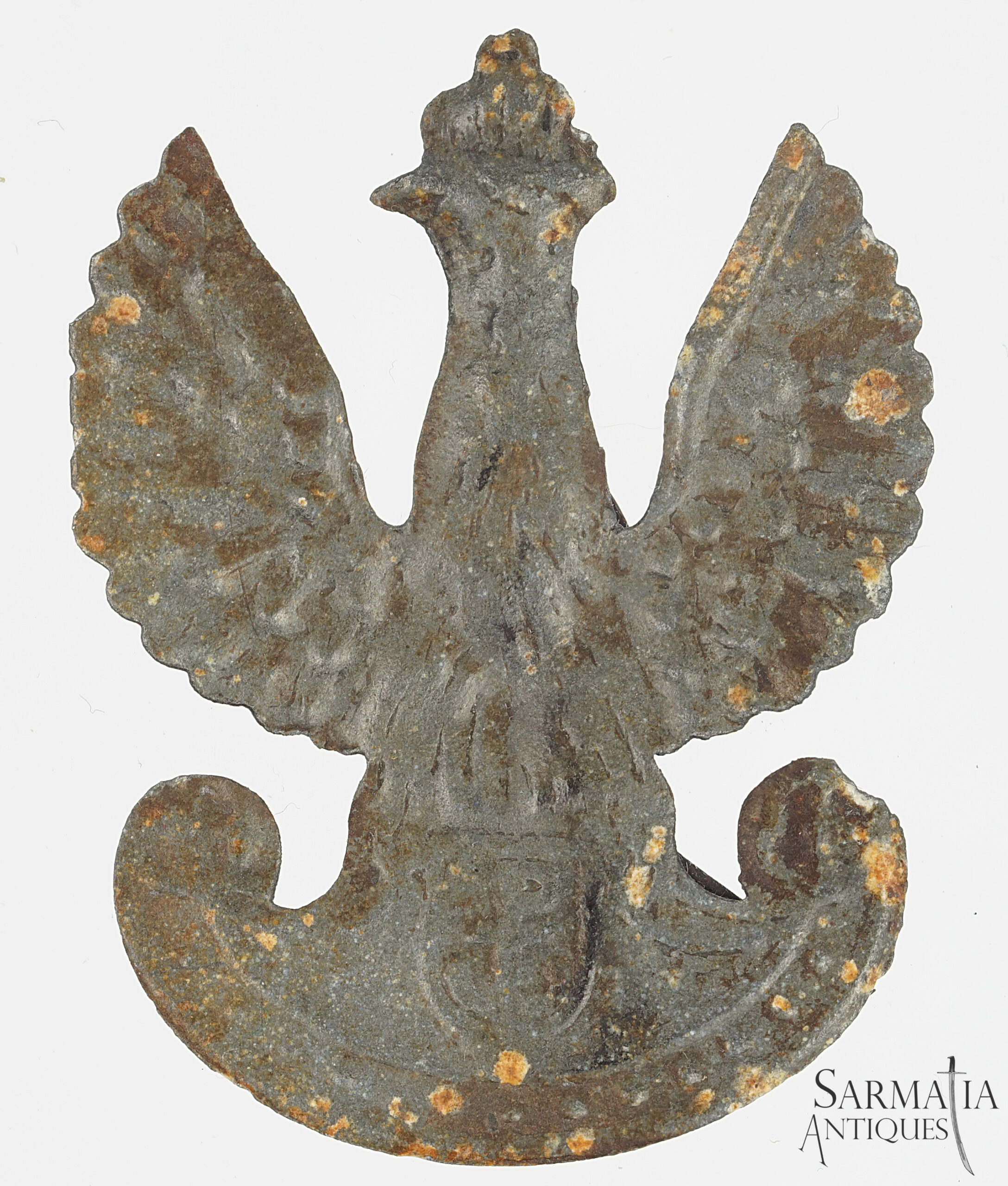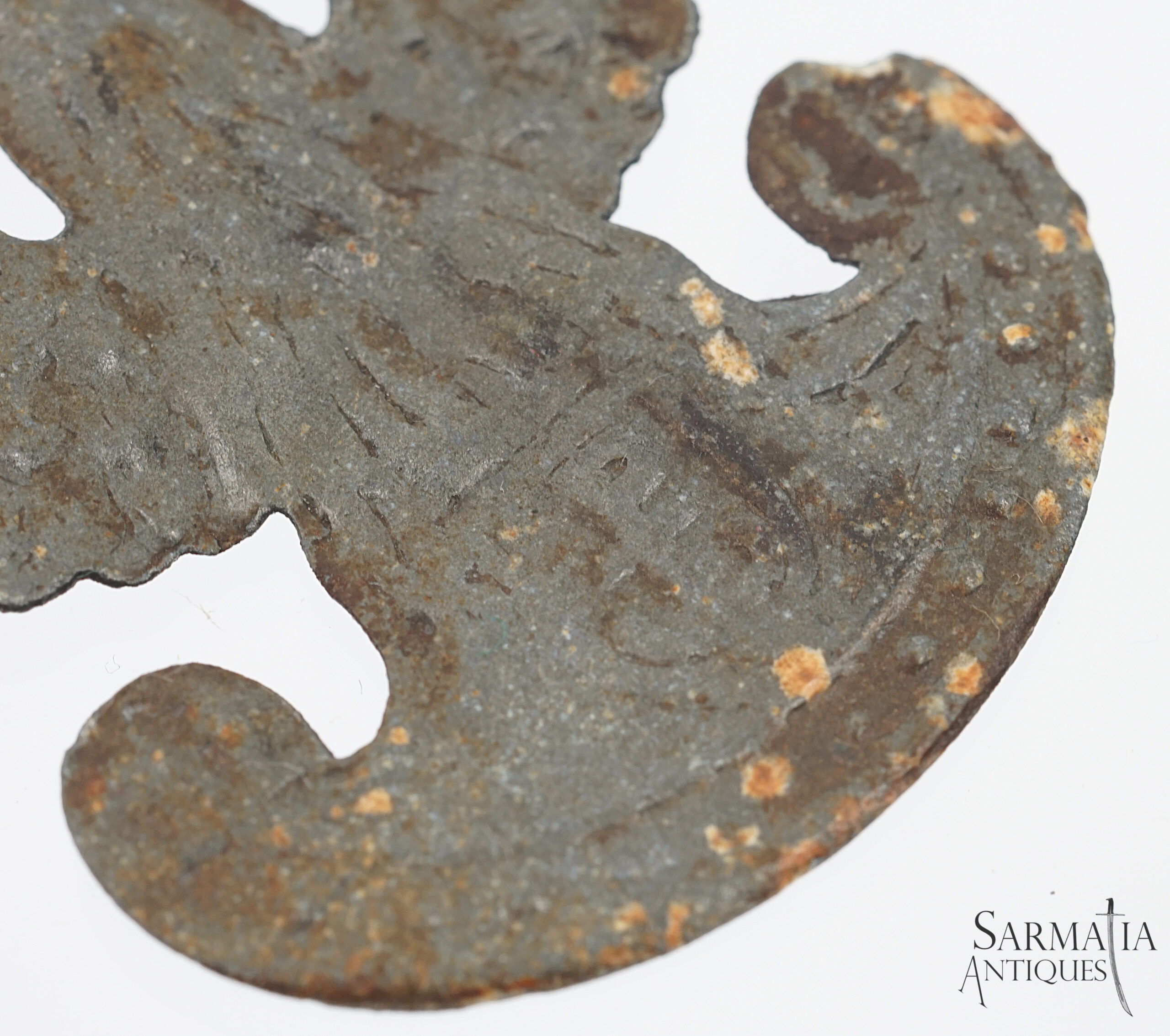
post-WW1 Polish-Bolshevik War Leaflet
December 18, 2018
pre-WW2 Scarce Polish Eagle Cap Badge wz.19
December 31, 2018WW2 Polish Resistance Eagle Cap Badge – Very Scarce Pruszkow production
Zinc, 1943-44, Pruszków, Poland.
31WW2 Polish Resistance Eagle Cap Badge, 1943-44, Pruszków, Poland. A badge of zinc, an eagle in a closed crown resting on an amazon shield. In the center of the Amazon shield a smaller shield on which is the so-called “Anchor” sign of the Fighting Poland (Resistance). On the reverse are the remnants of the solder from the fastening. General damage and wear, condition as on the pictures.
Polish Cap Badge produced in the home of Henryk and Janina Raczyński from Pruszków. In total, about 14,000 were minted, some of which fell into German hands during transport to Warsaw and very little survived to this day. Eagle intended for the branches of the Home Army in Warsaw and the surrounding area. This type of eagle cap badges is widely documented as used in the Warsaw Uprising by, among others, the “Radosław” Group.
The pattern of eagle cap badges is elaborately described by Mr. Tomasz Zawistowski in the book “Polskie Orły do Czapek w latach 1939-1945”, on pages 192-193, and in his article “Eagles with the Sign of Fighting Poland”:
http://www.polska1918-89.pl/pdf/orly-ze-znakiem-polski-walczacej,1580.pdf?fbclid=IwAR3tEBVjGSk1Xl6K3Tq3mF67MegLFfosFVh6XYSO4JKtEYzDzHfzc1RNark
The following information comes from his article:
“Eagles of Pruszkow
Operating since 1920 in Pruszków, the Industrial Plant of the Association of Polish Mechanics in America in the thirties engaged in the production of the Polish armaments industry, producing, among others, famous anti-tank guns licensed by Bofors. During the occupation, the plants were taken over by Warschauer Vereinigte Maschinenfabrik (WaVerMa), which launched the production of self-propelled guns in Sd. Kfz. 124 Wespe. The ZWZ / AK (Home Army) conspiracy organization used the plant for its own purposes, secretly producing, among others needles for grenade detonators, rifle needles and broaches for making barrels. At the turn of 1942 and 1943, one of the conspirators, Henryk Raczyński “Mur”, received from his friend, engineer Zbigniew Kredoszyński, an offer to undertake the production of eagles for soldiers of the Home Army. Matrices, punches and blanking dies, made out of several months of work and with the help of the engraver Henrik Lirsch, were smuggled to WaVerMy and hardened there. The Raczyński couple took the production of the eagles in their own home in Pruszków. Mr. Henry extruded eagles on the press placed on the bathroom window and cut them with a punch, and Mrs. Janina soldered to the backs of the fixing wires. The risk of slip-ups was high – it almost did occur while the hardened tools were removed from the plant. Another time, a German officer – a tenant of the Raczyński family – was close to discovering the truth. We know the history of eagle production thanks to two sources. The first is an interview with the Raczyński family, published in 1972 in the weekly magazine “Za Wolność i Lud” published by ZBOWiD, the second article from 1996 by Zdzisław Zaborski “Błyskawica”, the son of the director of the famous pencil factory “St. Majewski “, and in 1944 a soldier of the VII District of the AK” Obroża “. The drawing of the emblem was quite simple. On the Amazon shield was placed inner shield with an anchor symbol with an additional element – a horizontal line crossing the mark at half height. It is difficult to say what it was meant to symbolize. Perhaps it was about introducing to the monogram bound with the letters P and W an additional element in the form of a Latin cross? It is known that the first version of the eagle was not accepted by the headquarter. One can guess that as a result of this decision, the entire process of preparing the die, punch and punch, along with the most risky hardening under the enemy’s eye, had to be repeated. The second version, differing slightly in the drawing, with the characteristic narrow amazon shield, was accepted – the organization allocated funds for the purchase of sheet metal and serial production started. About 14,000 were made of zinc sheet metal and a few dozen of silver sheet. The large size of the production series exceeded the strength of a single tool, as evidenced is a broken matrix found in the set of tools for the production of Pruszków eagles in the collections of the Museum of the Polish Army. After the new matrix was made, the production of eagles was resumed. The ready eagles were referred to by Mrs. Raczyńska and wife of engineer Kredoszyński to the station of the Electrical Access Trailway in Pruszków. Then they went to underground magazines, and from them at the time of mobilization to insurgent hats. We know from the memory of the Raczyński family that just before the Uprising in Pęcice, a German officer discovered a Polish liaison Hanna Murzecka, “Walka,” who transported a packet of eagles and armbands to the concentration point of the 7th company of the “Paweł” Group. Archival photographs confirm the use of Pruszków eagles in various departments and districts. Certainly they were worn in Wola (district of Warsaw) in the “Miotła” Battalion, part of the “Radosław” Group, in Śródmieście (Centre of Warsaw) in the “Miłosz” Battalion and in Powiśle (district of Warsaw) in the “Krybar” Grouping. The presence of Pruszków eagles in so many districts confirms that they were distributed from central warehouses before the outbreak of fighting. In addition, it should be added that the drawing of the second version of the Pruszków eagle was published in a monograph in 1970, together with information on the production of such eagles in the Warsaw Mint. The fact that the underground Warsaw Mint produced eagle cap badges is probable, but they were probably a different of a unknown to us design. The sign of the anchor, which appeared on the shields of amazons of two insurgent eagles, returned years later and appears on several varieties of emblems worn by veterans of the Home Army. “








